For “Winged Wednesday”:
But, first this: Urgent: Poachers are massacring elephants.
“We're trying to get 85,000 letters to Congress by TODAY, July 18.
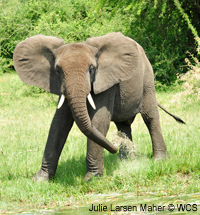 Last year was the most brutal year for African elephants since 1989.
Last year was the most brutal year for African elephants since 1989.
More than ever, elephants and other wildlife need our protection from poachers.
With the price of ivory skyrocketing, poachers have gone further than ever before in their lethal quest for profit – leaving a trail of carcasses behind them. The only way we'll stop 2012 from being even deadlier for elephants is by taking action now.
We need the full support of our government behind us to stop illegal and cruel poaching, so we're trying to get 85,000 letters to Congress by July 18. It will start with just one letter: YOURS.”
Ask your members of Congress not to cut funding for anti-poaching law enforcement. here.
_________
Honduran Emerald


“Named for its glittering blue-green throat and upper chest, the endangered Honduran Emerald is this country’s only endemic bird, and one of few birds endemic to any country in Central America.
Unfortunately, 90% of the emerald’s original habitat has been lost to agriculture and degraded by cattle grazing, and what remains occurs only in isolated patches of a few acres each. This has caused precipitous declines in the bird’s population.
In 2005, ABC supported the creation of the Honduran Emerald Reserve in the Aguan Valley – the first and so far only protected area for the species. However, a recent road improvement project will allow greater exploitation and more rapid loss of remaining habitat that is on private lands. As mitigation for the new road, an agreement has been made to increase the protected area by almost 2,000 acres.
The recent rediscovery of the species in the Santa Barbara Department marks the first time birds have been seen in western Honduras since 1935. This led to the species being downlisted from Critically Endangered to Endangered. However, new conservation initiatives are now needed to protect the new known sites of the Honduran Emerald, and maintain existing protection efforts.”
The Honduran Emerald Hummingbird in Amazing Slow Motion
“Spectacular footage of the Honduran Emerald, an endangered hummingbird threatened by habitat loss and degradation.” Video by Greg Homel
Help ABC conserve this and other birds and their habitats!
Photo by Greg Homel, Natural Elements Productions; Range Map, ABC
_____________
BIRDS ROCK! (heavy metal mix)
The film was supplied by the British Broadcasting Corporation, the U.S. Fish and Wildlife Service, and Greg Homel of Natural Elements Productions. Thanks also to the Jeniam Foundation for supporting Conservation Birding!
“The birds in the video are Andean Condor, Sandhill Crane, Galapagos Penguin, Andean Flamingo, Western Grebe, Dickcissel, Great Gray Owl, Long-tailed Manakin, Greater Sage-Grouse, Red-and-Green Macaw, Toco Toucan, Guianan Cock-of-the-Rock, Marvelous Spatuletail http://www.abcbirds.org/newsandreports/video/spatuletail.html, Tufted Puffin, Buff-breasted Sandpiper, Steller's Sea Eagle, Red Knot, Wandering Albatross, and Snow Goose.”
__________
Steller's Birds
Eagles, jays, eiders - and mammals, too!
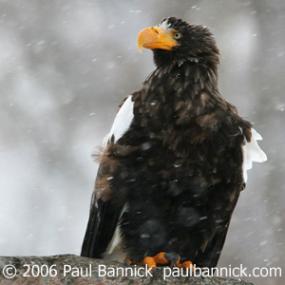
“In July, 1741, George Wilhelm Steller set foot on land later known as Alaska, the first European to do so. Steller was a German naturalist on the St. Peter, a Russian ship exploring the Bering Sea. He was shipwrecked on Bering Island for over a year, and later wrote a book about the creatures that lived on the island.
Many were ultimately named for this adventurous and feisty German, including this Steller's Sea Eagle, the Steller's Jay, and the Steller's Eider.”
Steller's Eider

“The smallest eider, the Steller's Eider is restricted to northern latitudes where it breeds in freshwater tundra ponds.
It spends the rest of the year in shallow marine waters. Birders rarely see it outside of Alaskan waters.”
__________
Bird Being Hit by Wind Turbine - Bird-Smart Wind Commercial
“Dramatic Video Shows Bird Strike at Wind Turbine: One Bird Currently Killed Every Minute by Wind Power in the U.S.
American Bird Conservancy (ABC), the nation's leading bird conservation organization, today distributed dramatic footage showing a wind turbine striking a bird—a poignant illustration of the dangers posed to birds by the burgeoning wind industry. The commercial encourages viewers to send a letter to the U.S. Fish and Wildlife Service asking that wind power be made bird-smart. See
http://www.abcbirds.org/newsandreports/releases/110405.html for more details.
Bird-smart wind power employs careful siting, operational and construction mitigation, and monitoring, as well as compensation to reduce and redress any unavoidable bird mortality and habitat loss from wind energy development. These are issues that should be included in mandatory federal wind standards.
Go to http://org2.democracyinaction.org/o/5400/p/dia/action/public/?action_KEY=9060 to sign the bird-smart wind petition.”
___________
American Bird Conservancy’s Policy Statement on Wind Energy and Bird-Smart Wind Guidelines: http://www.abcbirds.org/abcprograms/policy/collisions/wind_policy.html
__________
Showing Vultures A Little Love. by Robert Krulwich
 “Think of a giraffe lying on the Serengeti plain. He has just died, maybe of disease, maybe he was killed by a pride of lions, but now he's a 19-foot-long, 4,000-pound mound of meat, which very soon is going to stink and rot and muck up the neighborhood.
“Think of a giraffe lying on the Serengeti plain. He has just died, maybe of disease, maybe he was killed by a pride of lions, but now he's a 19-foot-long, 4,000-pound mound of meat, which very soon is going to stink and rot and muck up the neighborhood.
The lions that did it will eat roughly 35 pounds each. With five or six lions, that's a start, but there's a lot of giraffe left. Hyenas will help. Jackals will, too, but the bulk of the cleanup goes to the hero of my tale, nature's prize janitor — hard-working, efficient, unbeloved, unadmired and now down on its luck. I am talking about the vulture. The vulture needs a little bit of love ...

... not only because these busy birds clean up giraffes (and hippos and gazelles and lions in Africa) weighing, by one estimate, about 12 million kilograms, or the weight of about 200,000 men — but because they do it all over the world, gobbling up dead goats, cows, deer, rats at no charge, recycling that flesh back into other living things and then into the Earth.” More at: http://www.npr.org/blogs/krulwich/2012/07/03/156125689/showing-vultures-a-little-love
__________
Proper Wing Clipping
“I receive many questions about wing trimming, so this month I would like to discuss a "new" way to clip pet bird's wings, although I have been using this type of clip for well over ten years now. Many avian vets, breeders and pet retailers still clip the wings by cutting along the covert feathers, beginning at the tip of the wing. This type of trim leaves about 1/3 of the feather, under the level of the coverts (hopefully), if trimmed "correctly." Often, with this type of clip, it is easy to over-trim the wings, cutting all of the primary remiges and many of the secondary remiges, as well.
No matter what type of trim is employed, it should never be necessary to cut into the secondary feathers (those past the bend of the wing). In addition to cutting too many feathers, resulting in a bird that can no longer glide gently to the ground, this type of trim will predictably leave the sharp cut feather shafts (often cut at an angle, which makes them even more pointy and irritating!) I have often noted that birds that have been clipped in this fashion will often chew on the sharp, stiff cut shaft, trying to "soften" the point. African greys, cockatoos and Eclectus seem to be the most often aggravated by primary wing feathers cut in half. I have no doubt that this type of wing clip has precipitated many a bird to begin a feather-picking episode. If you doubt that birds don't like having partially cut feathers, check your bird's wings. Often the cut shaft has been chewed on, giving it a star-like appearance, almost like the cut tip has "exploded." This indicates that the bird is being bothered by the trim.
When a bird extends its wings after this ‘new’ type of clip, you will see no cut edges or ragged cut feathers at all. It is a cosmetically attractive clip, and I feel that it is kinder for a bird. Birds are very fussy about their feathers, and I have seen evidence of birds being frustrated, annoyed or aggravated by cut feathers poking them in the ribs.
I have also watched birds engaging in normal preening behavior, grasping a feather at the base, to begin preening, and then sliding the beak up the feather until the bird reaches the cut feather end. It then stops at the cut end to try to "preen" it. It may spend an inordinate amount of time obsessing on the cut ends, which feel abnormal to the bird. However, when a feather is clipped at the base of the quill, there is no feather there at all for the bird to preen, eliminating the problem entirely.”
Pictures and instructions at: http://www.exoticpetvet.net/avian/clip.html
___________
Baby birds saved from storm Debby by Wildlife Rehabilitation of Bradenton Beach
 BRADENTON BEACH -- “Gail Straight could use some sleep. But she's too busy handfeeding fish to a baby bird that fits in the palm of her hand. The skimmer is one of many found Sunday evening by the old Colony Beach & Tennis Resort on Longboat Key. Blame it on Tropical Storm Debby. Of the original 100 or so skimmers spotted, 32 have made it safely to Wildlife Education & Rehabilitation Center Inc. It's the Bradenton Beach facility where Gail and husband Ed Straight have cared for countless critters during the past quarter-century.
BRADENTON BEACH -- “Gail Straight could use some sleep. But she's too busy handfeeding fish to a baby bird that fits in the palm of her hand. The skimmer is one of many found Sunday evening by the old Colony Beach & Tennis Resort on Longboat Key. Blame it on Tropical Storm Debby. Of the original 100 or so skimmers spotted, 32 have made it safely to Wildlife Education & Rehabilitation Center Inc. It's the Bradenton Beach facility where Gail and husband Ed Straight have cared for countless critters during the past quarter-century.
Gail saved the baby birds with help from her 13-year-old grandson Devon Straight. "The storm was coming and they were getting lost from their families," Gail said. "There was sand in their eyes, in every place. The others were either picked by seagulls, terns, got washed away in the water or covered by so much sand you couldn't find them."” More at: http://www.bradenton.com/2012/06/26/4091931/baby-birds-saved-from-storm-by.html
__________
Males are not wanted and killed
“Americans eat an average of about 27-28 chickens a year. Two types of chickens are raised by farmers, layers and boilers, with dramatically different bodies and metabolisms. Layers are all females.
Approximately 250 million male "layer" chicks are killed each year shortly after birth because they have no commercial value.” SOURCE: Eating Animals
__________
Tribute to Nature Educators. Opening the door to nature for children!
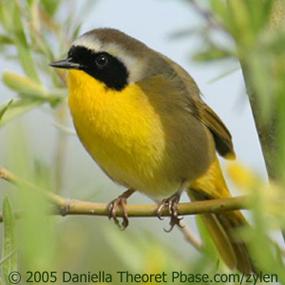
“Our childhood experiences of nature stay with us for a lifetime. Yet someone must first show a child the delights and knowledge of the natural world. Imagine a child seeing this Common Yellowthroat for the very first time!
Today, we celebrate the nature educators who give the gifts of their time and knowledge. We're grateful for the invaluable service they provide! Consider sending your child - or another - to an Audubon nature camp.”
___________
Birds and Baseball
Cardinals and Orioles and Blue Jays! Oh my!
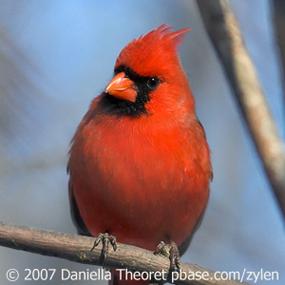
“At the crack of the bat, a Blue Jay flies toward first and glides around the base. Deep in left field, an Oriole pounces on the ball. He wings the ball toward second, where a fellow Oriole snares it on a hop - just as the swift Blue Jay slides toward the base in a cloud of red dust. Ahh, summer baseball!
A real Blue Jay and an authentic Baltimore Oriole, taken by photographer Pat Hemlepp. And thanks to Daniella Theoret for this Northern Cardinal.”
__________
On This Day:
Nero's Rome burns, Jul 18, 64:“The great fire of Rome breaks out and destroys much of the city on this day in the year 64. Despite the well-known stories, there is no evidence that the Roman emperor, Nero, either started the fire or played the fiddle while it burned. Still, he did use the disaster to further his political agenda.
The fire began in the slums of a district south of the legendary Palatine Hill. The area's homes burned very quickly and the fire spread north, fueled by high winds. During the chaos of the fire, there were reports of heavy looting. The fire ended up raging out of control for nearly three days. Three of Rome's 14 districts were completely wiped out; only four were untouched by the tremendous conflagration. Hundreds of people died in the fire and many thousands were left homeless.
Although popular legend holds that Emperor Nero fiddled while the city burned, this account is wrong on several accounts. First, the fiddle did not even exist at the time. Instead, Nero was well known for his talent on the lyre; he often composed his own music. More importantly, Nero was actually 35 miles away in Antium when the fire broke out. In fact, he let his palace be used as a shelter.
Legend has long blamed Nero for a couple of reasons. Nero did not like the aesthetics of the city and used the devastation of the fire in order to change much of it and institute new building codes throughout the city. Nero also used the fire to clamp down on the growing influence of Christians in Rome. He arrested, tortured and executed hundreds of Christians on the pretext that they had something to do with the fire.”
___________
Yesterday:
My oldest son, Peter, turned 55 yesterday, I guess I am getting old, though I don’t feel like I am. Many Happy Returns, Peter.
As neither Jay nor Ray were going to be here, I knew I had to use the morning to get back to sewing the drapes for the cargo trailer. I oiled the sewing machine, and then mended a few things to make sure that there was no oil residue and that the tension was still set right. I did get some drapes pleated and hemmed, in between interruptions, but there is still a lot of sewing to do.
Ray’s car came back with it’s new fuel pump and coil, so he was washing it ready to put it back on the road. The sky was overcast, suddenly there was a big downpour. He rushed back inside leaving his buckets and brushes on the ground. He didn’t even have time to drive it back into his carport. It didn’t last long, so he went back to washing it, to get the rain water off.
We have a 30% chance of another thunderstorm at 1.00PM today.




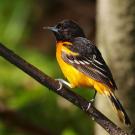
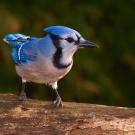















1 comment:
What a difference a year makes. We were wishing and praying for rain last year.
Post a Comment